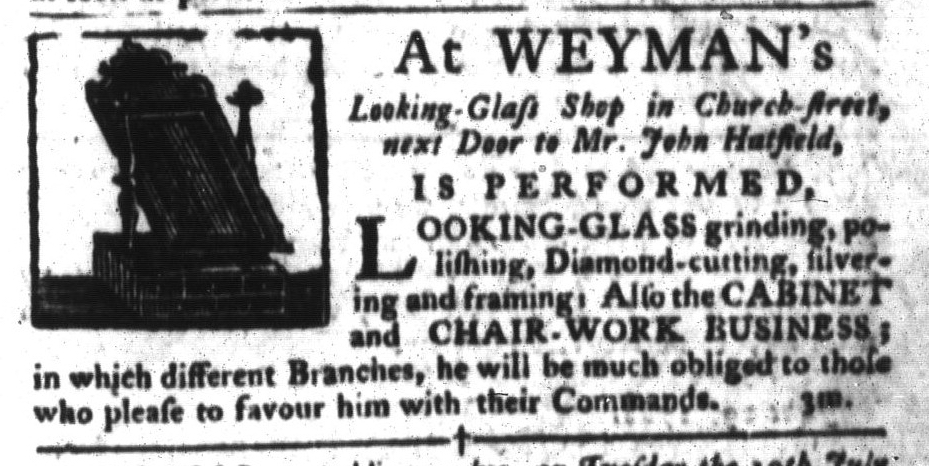What was advertised in a colonial American newspaper 250 years ago today?

“At WEYMAN’s Looking-Glass Shop.”
Edward Weyman’s advertisements for his “Looking-Glass Shop in Church-street” in Charleston were easily recognizable when they appeared in the South-Carolina Gazette and Country Journal. In addition to using to his surname as a headline, Weyman included an image of a looking glass mounted in an elaborately carved frame. While Weyman’s woodcut certainly was not a sophisticated engraving, the processes of remediating the image over the years – photography and digitization – likely make it appear more crude than it looked to colonists who read the newspaper when it was first published or even to modern researchers who consult original copies in libraries and archives rather than the digital surrogates more widely accessible in the twenty-first century. This process is compounded when printing images from the digital ones, a process that tends to create even darker and denser images. In other words, Weyman’s woodcut may look like a dark mass to modern eyes, but that is contingent in part on the format in which it is presented for our consumption. Eighteenth-century viewers would have seen a crisper image. They would have more easily noticed the lines and details that do not translate well via subsequent remediation. It remains important not to overstate the quality of this and other woodcuts, but at the same time we should avoid denigrating them as excessively crude unnecessarily.
Besides, Weyman’s woodcut served its purpose. Other than the masthead, only three images appeared in the July 12, 1768, edition of the South-Carolina Gazette and Country Journal. Two of them were stock images that belonged to the printer: a woodcut of a house that accompanied a real estate advertisement and a woodcut of a slave that accompanied a fugitive advertisement. Weyman’s woodcut of a looking glass was the only one commissioned by the advertiser, the only one used exclusively by a particular advertiser rather than interchangeably in advertisements of the corresponding genre. Weyman advertised frequently, making his woodcut a familiar image to regular readers of the South-Carolina Gazette and Country Journal. In effect, it created a logo or a brand that readers could immediately identify. Its mere repetition over weeks and months, especially as an especially distinctive visual element, likely secured a place for Weyman in the minds of readers. Even if they did not need or want looking glasses when they glimpsed his advertisements, they were likely to remember his workshop when they were in the market to make such purchases.
